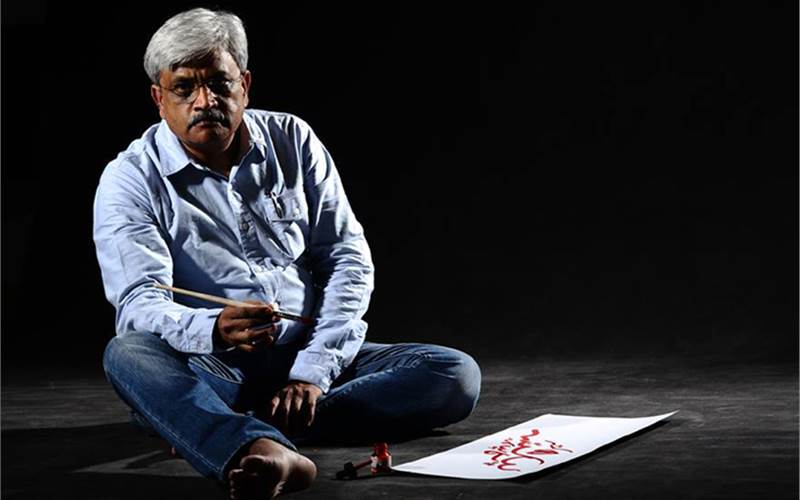Exhibition showcases the development of Devanagri letterform
A digital art show, titled ‘Fontwala: Stone to Mobile, What Remains?’ by Rajeev Prakash Khare and Shubhra Prakash, showcased the development of the Devanagri letterform from its earliest stone engravings to its digital adaptations. Organised by Kaleidoscope Digital Art, the show was on at KDA, Triveni Kala Sangam, New Delhi, from 27 July to 17 August 2019.
19 Aug 2019 | By Rahul Kumar
The show explored the journey of the Indian letterform, specifically through Devanagri script, and investigated what is lost and what remains from times when legacies were written in stone and metal to now, when the letterform of the Indian languages have found a presence on various technical mediums.
Indian letterforms were labelled complex scripts until the arrival of Unicode that enabled their development in digital mode. Through Khare’s perspective and experience as a typeface designer and calligrapher, the exhibit reflected on the pioneers who maintained the aesthetics of the letterform, the challenges experienced in transition from one medium to another; and the possibilities that lie ahead for the letterform and a call for technical adjustments to accommodate the legacy of notable Indian scripts.
As the creative producer, Shubra Prakash distilled the vast content of typeface history and Khare’s commitment towards it.
The seven videos at the show presented the development of Devanagri from Brahimi and its evolving mediums — stone pillars to digital screens. Khare and Prakash unravelled the embryonic interconnection of all akshars and the inherent beauty of the script with its maatras and other accents.
The show brought forth Khare’s commitment to preserving the Indian typeface against the background of a rapidly evolving digital era. Khare builds his practice on the earlier work of typeface pioneers to preserve the integrity of the Indian script as technology changed from printing press to digitisation for computers to mobile screens. What readers take for granted as an easy transformation was, and still is fraught with challenges of technology as well as easy readability. The size of the font or typeface design itself impacts how it is received on various platforms.

Khare focused his practice and artistic responsibility on preserving the graceful beauty and rich cultural heritage that is encapsulated within the script and language. Language is the carrier of cultural systems. Script is mode of communication it to a wider population. Loss of language results in the eventual loss of culture. It has been observed historically that the substitution of local scripts with a politically dominant script led to eventual corrosion of script, language and eventually the indigenous culture. In recent colonial history, complex Asian scripts were substituted by easily available Roman script for the convenience of transferring into new mediums.
Khare, who has been fascinated with akshar since childhood, has artistically and technically explored all mediums — be it painted wall advertisements or software design for industrial applications. His love for the Devanagri font manifests as akshars that float in front of his eyes as visions. He converts these aesthetic visions in to a typeface that is accessible to the reader, while staying true to is integral identity. He says, “The work is not fulfilled till it is received and understood by the reader.”
The curator Mukta Ahluwalia said, “I truly believe in the power of contemporary art and new technologies to bring about positive social change. Through ‘Fontwala’, the audience gets a glimpse in the continuity between Devanagri and Brahimi scripts. One also gets to see the perhaps otherwise overlooked ornamental beauty of the script as explained by Khare. One takes digitisation of the age-old script for granted. The show offers a pause into challenges and dedication of Khare and other typeface pioneers.”
Bobby Bedi, the founder of KDA, said, “Digital lets you experience art with all your senses. Moreover, Digital art can be created and shared in the original by millions. KDA is committed to ensuring that artists, young and old, get an opportunity to share their digital vision.”
Rajeev Prakash Khare has been trained as a calligrapher and typographer under the renowned calligrapher and father of today’s digital Indian language typography Prof RK Joshi and Mr Gopal Bhai Modi, founder of Gujarat Type Foundry, Mumbai. In the 1990s, Rajeev founded VSOFT, a type design software company and worked with significant institutions including the Indian government.
Shubhra Prakash is a theatre artist, who most recently co-wrote produced and acted in an original play The Music in My Blood.












 See All
See All